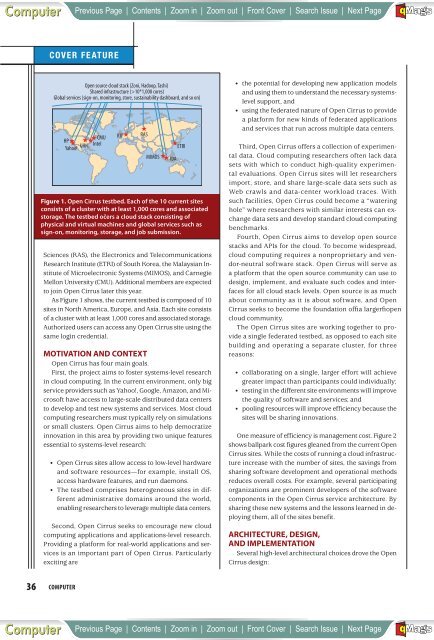computing lives - FTP Directory Listing
computing lives - FTP Directory Listing
computing lives - FTP Directory Listing
You also want an ePaper? Increase the reach of your titles
YUMPU automatically turns print PDFs into web optimized ePapers that Google loves.
A<br />
Computer Previous Page | Contents | Zoom in | Zoom out | Front Cover | Search Issue | Next Page M S BE<br />
aG<br />
F<br />
36<br />
COVER FEATURE<br />
Open source cloud stack (Zoni, Hadoop, Tashi)<br />
Shared infrastructure (>10*1,000 cores)<br />
Global services (sign-on, monitoring, store, sustainability dashboard, and so on)<br />
COMPUTER<br />
HP<br />
UIUC Intel<br />
CMU<br />
Yahoo!<br />
KIT<br />
RAS<br />
MIMOS<br />
Figure 1. Open Cirrus testbed. Each of the 10 current sites<br />
consists of a cluster with at least 1,000 cores and associated<br />
storage. The testbed očers a cloud stack consisting of<br />
physical and virtual machines and global services such as<br />
sign-on, monitoring, storage, and job submission.<br />
Sciences (RAS), the Electronics and Telecommunications<br />
Research Institute (ETRI) of South Korea, the Malaysian Institute<br />
of Microelectronic Systems (MIMOS), and Carnegie<br />
Mellon University (CMU). Additional members are expected<br />
to join Open Cirrus later this year.<br />
As Figure 1 shows, the current testbed is composed of 10<br />
sites in North America, Europe, and Asia. Each site consists<br />
of a cluster with at least 1,000 cores and associated storage.<br />
Authorized users can access any Open Cirrus site using the<br />
same login credential.<br />
MOTIVATION AND CONTEXT<br />
Open Cirrus has four main goals.<br />
First, the project aims to foster systems-level research<br />
in cloud <strong>computing</strong>. In the current environment, only big<br />
service providers such as Yahoo!, Google, Amazon, and Microsoft<br />
have access to large-scale distributed data centers<br />
to develop and test new systems and services. Most cloud<br />
<strong>computing</strong> researchers must typically rely on simulations<br />
or small clusters. Open Cirrus aims to help democratize<br />
innovation in this area by providing two unique features<br />
essential to systems-level research:<br />
Open Cirrus sites allow access to low-level hardware<br />
and software resources—for example, install OS,<br />
access hardware features, and run daemons.<br />
The testbed comprises heterogeneous sites in different<br />
administrative domains around the world,<br />
enabling researchers to leverage multiple data centers.<br />
Second, Open Cirrus seeks to encourage new cloud<br />
<strong>computing</strong> applications and applications-level research.<br />
Providing a platform for real-world applications and services<br />
is an important part of Open Cirrus. Particularly<br />
exciting are<br />
IDA<br />
ETRI<br />
the potential for developing new application models<br />
and using them to understand the necessary systemslevel<br />
support, and<br />
using the federated nature of Open Cirrus to provide<br />
a platform for new kinds of federated applications<br />
and services that run across multiple data centers.<br />
Third, Open Cirrus offers a collection of experimental<br />
data. Cloud <strong>computing</strong> researchers often lack data<br />
sets with which to conduct high-quality experimental<br />
evaluations. Open Cirrus sites will let researchers<br />
import, store, and share large-scale data sets such as<br />
Web crawls and data-center workload traces. With<br />
such facilities, Open Cirrus could become a “watering<br />
hole” where researchers with similar interests can exchange<br />
data sets and develop standard cloud <strong>computing</strong><br />
benchmarks.<br />
Fourth, Open Cirrus aims to develop open source<br />
stacks and APIs for the cloud. To become widespread,<br />
cloud <strong>computing</strong> requires a nonproprietary and vendor-neutral<br />
software stack. Open Cirrus will serve as<br />
a platform that the open source community can use to<br />
design, implement, and evaluate such codes and interfaces<br />
for all cloud stack levels. Open source is as much<br />
about community as it is about software, and Open<br />
Cirrus seeks to become the foundation offia largerfiopen<br />
cloud community.<br />
The Open Cirrus sites are working together to provide<br />
a single federated testbed, as opposed to each site<br />
building and operating a separate cluster, for three<br />
reasons:<br />
collaborating on a single, larger effort will achieve<br />
greater impact than participants could individually;<br />
testing in the different site environments will improve<br />
the quality of software and services; and<br />
pooling resources will improve efficiency because the<br />
sites will be sharing innovations.<br />
One measure of efficiency is management cost. Figure 2<br />
shows ballpark cost figures gleaned from the current Open<br />
Cirrus sites. While the costs of running a cloud infrastructure<br />
increase with the number of sites, the savings from<br />
sharing software development and operational methods<br />
reduces overall costs. For example, several participating<br />
organizations are prominent developers of the software<br />
components in the Open Cirrus service architecture. By<br />
sharing these new systems and the lessons learned in deploying<br />
them, all of the sites benefit.<br />
ARCHITECTURE, DESIGN,<br />
AND IMPLEMENTATION<br />
Several high-level architectural choices drove the Open<br />
Cirrus design:<br />
A<br />
Computer Previous Page | Contents | Zoom in | Zoom out | Front Cover | Search Issue | Next Page M S BE<br />
aG<br />
F

















